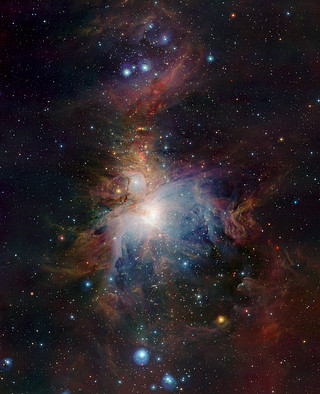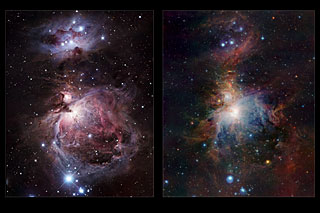VISTA: Orion in a New Light
Posted: Wed Feb 10, 2010 3:30 pm
APOD and General Astronomy Discussion Forum
https://asterisk.apod.com/
The Orion Nebula reveals many of its hidden secrets in a dramatic image taken by ESO’s new VISTA survey telescope. The telescope’s huge field of view can show the full splendour of the whole nebula and VISTA’s infrared vision also allows it to peer deeply into dusty regions that are normally hidden and expose the curious behaviour of the very active young stars buried there.

This wide-field view of the Orion Nebula (Messier 42), lying about 1350 light-years from Earth, was taken with the VISTA infrared survey telescope at ESO’s Paranal Observatory in Chile. The new telescope’s huge field of view allows the whole nebula and its surroundings to be imaged in a single picture and its infrared vision also means that it can peer deep into the normally hidden dusty regions and reveal the curious antics of the very active young stars buried there. This image was created from images taken through Z, J and Ks filters in the near-infrared part of the spectrum. The exposure times were ten minutes per filter. The image covers a region of sky about one degree by 1.5 degrees.

On the upper-left, the central region of VISTA’s view of the Orion Nebula is shown, centred on the four dazzling stars of the Trapezium. A rich cluster of young stars can be seen here that is invisible in normal, visible light images. In the lower-right panel the part of the nebula to the north of the centre is shown. Here there are many young stars embedded in the dust clouds that are only apparent because their infrared glow can penetrate the dust and be detected by the VISTA camera. Many outflows, jets and other interactions from young stars are apparent, seen in the infrared glow from molecular hydrogen and showing up as red blobs. On the upper-right, a region to the west of centre is shown. Here the fierce ultraviolet light from the Trapezium is sculpting the gas clouds into curious wavy shapes. A distant edge-on spiral galaxy is also seen shining right through the nebula. At the lower-left a region south of the centre is shown. Each extract covers a region of sky about nine arcminutes across.

The left-hand panel shows the Orion Nebula in visible light. Most of the light from the spectacular clouds comes from hydrogen gas glowing under the fierce ultraviolet glare from the central hot young stars. The region above the centre is clearly obscured by dust clouds. On the right the VISTA infrared view is shown. By observing infrared light many new features appear, including large numbers of young stars close to the centre and many curious red objects, associated with young stars and their outflows, in the region above the centre.

PR Video eso1006a - ESOcast 14: Orion in a New LightThe left-hand panel shows a dusty region of the Orion Nebula in visible light. On the right the VISTA infrared view is shown. By observing infrared light many new features appear, including many young stars and their outflows. These strange features are of great interest to astronomers studying the birth and youth of stars.